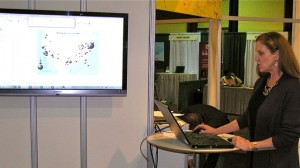Turn on suggestions
Auto-suggest helps you quickly narrow down your search results by suggesting possible matches as you type.
Cancel
- Home
- :
- All Communities
- :
- Industries
- :
- Education
- :
- Education Blog
- :
- Integrating Technology with Meaningful Learning
Integrating Technology with Meaningful Learning
Subscribe
651
0
06-28-2017 11:35 PM
- Subscribe to RSS Feed
- Mark as New
- Mark as Read
- Bookmark
- Subscribe
- Printer Friendly Page
06-28-2017
11:35 PM
David Jonassen (1995) described seven qualities of meaningful learning with technology. They are: active, constructive, collaborative, intentional, conversational, contextualized, and reflective. These are valuable not only to keep in mind when teaching with GIS, but to be purposeful, asking before each class, “How can I be active in my teaching with GIS today?” “How can I be conversational?” and so on.
Those I know who teach with GIS are good examples of putting these qualities into practice. Their teaching is never just for the technology’s sake, even when it is with the goal of increasing the students’ GIS skills for career readiness. They teach in context and with a purpose, asking students to reflect on problem-solving, data, scale, critical thinking, and more. Jonassen and others make a strong case for the value of situated learning, or learning in context, which is exactly what teaching with GIS entails.

Jonassen’s three assumptions about technology are also instructive. These include the following:
- Technology is more than hardware; it consists of the designs that engage learners.
- Learning technology is any environment of a definable set of activities that engages learners in knowledge construction.
- Knowledge construction is not supported by technologies used as conveyors of instruction that prescribe and control all learner interactions. Rather, technologies support knowledge construction better when they are need-driven or talk-driven, learner-initiated, and when interactions with the technologies are conceptually and intellectually engaging.
Technologies as toolkits enable learners to build more meaningful personal interpretations and representations of the world.
According to Jonassen, learners and technologies should be “intellectual partners”, an intriguing concept in which the cognitive responsibilities for performing are distributed by the part of the partnership that performs it best. Let’s say you are studying the relationship between elevation and rainfall on the windward and leeward sides of mountains. Calculating how much rainfall occurs at different elevations and on the western versus the eastern sides of the mountains through overlay would be something you would let the GIS software do. But your final assessment that incorporates multimedia and a presentation relies more heavily on your own input and reflection—not something that the software can do. This is one of my favorite things about teaching and learning with GIS. The software is the enabler and the GIS user provides the solution.
How are you incorporating elements of Jonassen’s seven qualities in your own GIS-based instruction?
- Joseph Kerski, Esri Education Manager
You must be a registered user to add a comment. If you've already registered, sign in. Otherwise, register and sign in.
About the Author
I believe that spatial thinking can transform education and society through the application of Geographic Information Systems for instruction, research, administration, and policy.
I hold 3 degrees in Geography, have served at NOAA, the US Census Bureau, and USGS as a cartographer and geographer, and teach a variety of F2F (Face to Face) (including T3G) and online courses. I have authored a variety of books and textbooks about the environment, STEM, GIS, and education. These include "Interpreting Our World", "Essentials of the Environment", "Tribal GIS", "The GIS Guide to Public Domain Data", "International Perspectives on Teaching and Learning with GIS In Secondary Education", "Spatial Mathematics" and others. I write for 2 blogs, 2 monthly podcasts, and a variety of journals, and have created over 6,500 videos on my Our Earth YouTube channel.
Yet, as time passes, the more I realize my own limitations and that this is a lifelong learning endeavor: Thus I actively seek mentors and collaborators.
Labels
-
Administration
65 -
Announcements
68 -
Career & Tech Ed
1 -
Curriculum-Learning Resources
233 -
Education Facilities
24 -
Events
60 -
GeoInquiries
1 -
Higher Education
566 -
Informal Education
273 -
Licensing Best Practices
75 -
National Geographic MapMaker
27 -
Pedagogy and Education Theory
209 -
Schools (K - 12)
282 -
Schools (K-12)
240 -
Spatial data
30 -
STEM
3 -
Students - Higher Education
240 -
Students - K-12 Schools
116 -
Success Stories
33 -
TeacherDesk
1 -
Tech Tips
101
- « Previous
- Next »